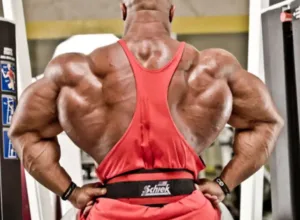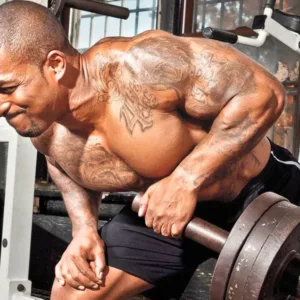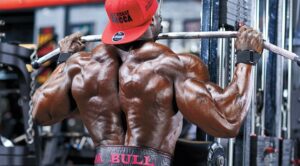The Back is a crucial muscle group, not just for aesthetics but also for overall strength, posture, and injury prevention. A Well-developed back contributes to powerful movements like deadlifts, supports proper spinal alignment, and improves athletic performance.
Everything you need to know about sculpting a strong, healthy upper, middle, and lower back
-
Who Needs to Train Their Back?
-
Powerlifters, Strongman competitors, and Weightlifters
-
Athletes
- Related Articles: Build Strength In Your “Legs And Back” With This Great Exercise
-
People with manual labor jobs
-
People with sedentary jobs or lifestyles
-
People with back pain
-
Back Anatomy 101
-
Erector Spinae
-
Latissimus dorsi
-
Trapezius
-
Rhomboids
-
Warming up before back training
- Related Articles: How “The Close Grip Lat Pulldown Exercise” Pumps Your Back And Your Biceps At The Same Movement
Check Out Our List Of The Best Supplements For Building Muscle, Shredding Muscle, Recovery, And Great Health, and Wellness Products! Purchase ifbnewsfeed.org‘s apparels Here: ifbnewsfeed.org

 This article dives into the best back exercises for building muscle strength and size, catering to different experience levels and equipment availability.
This article dives into the best back exercises for building muscle strength and size, catering to different experience levels and equipment availability.
Compound Lifts: The Foundation for Back Development
Compound lifts, exercises that engage multiple muscle groups at once, are the cornerstone of any back-building program. These exercises stimulate significant muscle growth by working your entire back along with supporting muscles.
- Barbell Deadlift: The king of back exercises, the deadlift works your entire posterior chain, including your hamstrings, glutes, erector spinae (lower back muscles), and lats (lats dorsi, the large muscles in your mid-back).
Here’s how to perform a deadlift:
- Stand with your feet shoulder-width apart and the barbell gripped slightly wider than shoulder-width.
- Hinge at your hips and knees, keeping your back flat and core engaged, to lower the bar down your shins.
- Drive through your heels to stand tall, squeezing your glutes and upper back at the top.
- Barbell Bent-Over Row: This variation of the deadlift targets your upper and mid-back muscles (lats, rhomboids, traps).
Here’s how to perform a barbell bent-over row:
- Set up with a barbell on the ground. Hinge at your hips and knees, keeping your back flat and core engaged, grabbing the bar with an overhand grip (palms facing down).
- Row the bar up to your lower chest, squeezing your shoulder blades together at the top.
- Slowly lower the bar back down to the starting position.
Isolation Exercises: Refining Your Back Definition
While compound lifts are essential, isolation exercises allow you to focus on specific back muscles for targeted development and sculpting.
- Pull-Ups: A bodyweight exercise that requires no equipment, pull-ups are a fantastic way to build upper back strength and size. They primarily target your lats and biceps.
Here’s how to perform a pull-up:
- Grab a pull-up bar with an overhand grip (palms facing away from you).
- Pull yourself up until your chin clears the bar, squeezing your back muscles at the top.
- Slowly lower yourself back down to the starting position.
- Seated Cable Row: This machine exercise provides excellent isolation for your mid-back muscles.
Here’s how to perform a seated cable row:
- Sit on a cable row machine and adjust the seat and handle height for proper form.
- Pull the handle towards your chest, squeezing your shoulder blades together at the end of the movement.
- Slowly release the handle back to the starting position.

 Additional Exercises for a Well-Rounded Back Workout
Additional Exercises for a Well-Rounded Back Workout
-
Dumbbell Row: A versatile exercise that can be done with one arm at a time for better core engagement and addressing any imbalances. It targets your upper and mid-back muscles.
-
Face Pulls: An excellent exercise for strengthening the rotator cuff muscles, which contribute to shoulder stability and overall back health.
-
Lat Pulldown: A machine exercise that allows for controlled movement and targets your lats.
Building a Back Workout Routine
Here’s a sample back workout routine incorporating both compound and isolation exercises:
- Warm-up: 5-10 minutes of light cardio and dynamic stretches
- Barbell Deadlift: 3 sets of 5-8 repetitions (heavy weight)
- Pull-Ups: 3 sets of as many repetitions as possible (AMRAP)
- Barbell Bent-Over Row: 3 sets of 8-12 repetitions
- Seated Cable Row: 3 sets of 10-15 repetitions
- Dumbbell Row: 3 sets of 12-15 repetitions per arm
- Face Pulls: 3 sets of 15-20 repetitions
The Best Back Exercises

 Additional Tips for Building Back Strength and Size
Additional Tips for Building Back Strength and Size
Here are some additional tips to maximize your back-building efforts:
- Mind-Muscle Connection: Focus on feeling the targeted muscles working throughout each exercise. This helps improve neuromuscular control and leads to better results.
- Slow and Controlled Movements: Avoid using momentum to lift the weight. Instead, focus on slow, controlled movements during both the lifting and lowering phases of each exercise.
- Proper Form is Paramount: Using proper form is crucial to prevent injuries and maximize muscle activation. Don’t hesitate to seek guidance from a personal trainer if you’re unsure about your form.
- Nutrition: Feed your muscles with a healthy diet rich in protein and complex carbohydrates to support muscle growth and repair.
Wrapping Up
Building a strong and sculpted back requires dedication and consistency. “By incorporating the exercises mentioned above into your workout routine, focusing on proper form, and following the training principles, you’ll be well on your way to achieving the back you’ve always desired”. Remember, patience is key – don’t get discouraged if you don’t see results overnight. Stick with your program, eat right, and get enough rest, and you’ll be amazed at the progress you can make!
More About Building a Back Workout Routine Contents
- How To Build A Massive Back With T-Bar Rows: “How-To, Muscles Worked, And Variations”
- The “10 Best Back Exercises” For Men To Build A Shredded V-Taper Back

- Hormone Replacement Therapy regimen For Men and women
- Hormone Blood Testing for Men (Bodybuilder Blood Testing)
- Shop Optimum Nutrition Energy: Anytime & Pre-Workout
For More News And Daily Updates, Follow IFBNewsfeed.Org™🇺🇸 on Facebook, Twitter, and Instagram. Comment, Like, And Share With Everyone Who May Need To Be Updated With The Most Recent Fitness/Bodybuilding/Powerlifting And CrossFit News.







